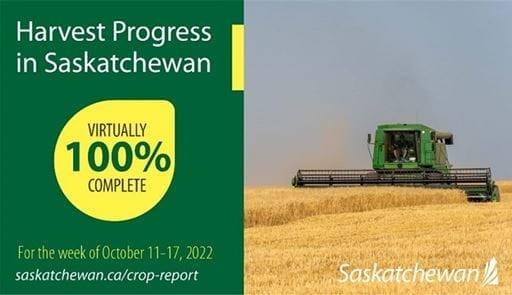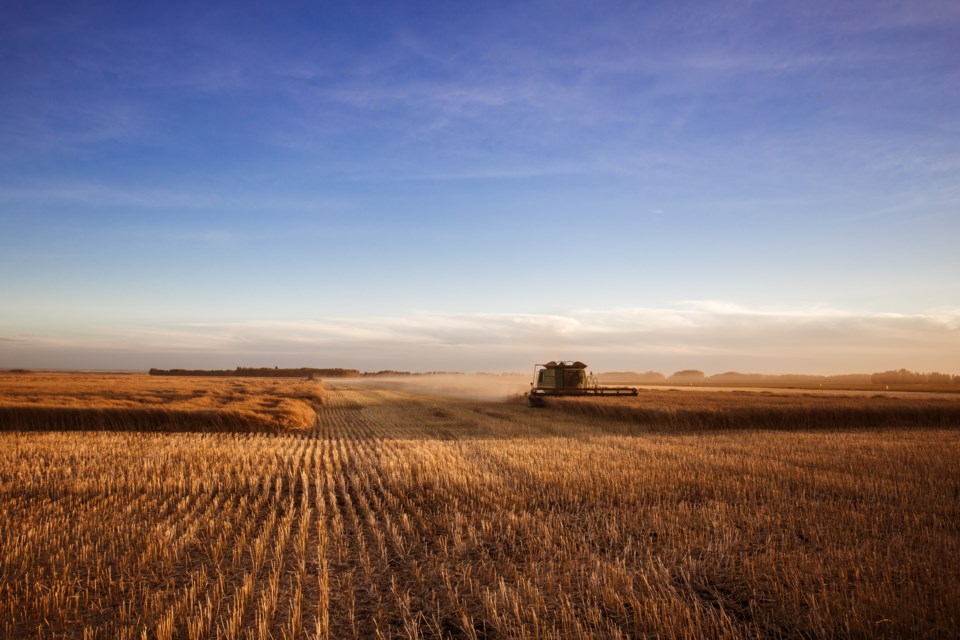REGINA - Harvest is virtually complete across Saskatchewan as dry weather through much of September and October allowed producers to effectively harvest their crops without major weather delays.
Harvest started early for many producers in the southwest and west-central regions after another dry growing season. Late seeding dates and weekly precipitation during the flowering and seed filling stages delayed harvest in the eastern and northern parts of the province until the latter half of August, but resulted in higher yield potential. However, the weather remained dry, and producers were able to gain momentum with their harvest and get all their crop in without any major issues.
Now that harvest is complete in all regions of the province, producers would like to see some steady precipitation before the ground freezes and winter arrives.

Crop yields vary throughout the province, depending heavily on the amount of moisture received throughout the season. Yields in the southwest and west-central regions are once again below average, with some producers reporting slightly improved yields compared to last year. Yields in the eastern and northern regions were much improved and many producers are reporting yields higher than average. The largest impacts on yields this year were drought, gophers, grasshoppers, wind and drowned out crops in the spring.
Average yields are being estimated as 44 bushels per acre for hard red spring wheat, 31 bushels per acre for durum, 93 bushels per acre for oats, 64 bushels per acre for barley, 36 bushels per acre for canola, 34 bushels per acre for peas and 1,165 pounds per acre for lentils.
Quality ratings for all crops are largely in the top two grade categories for each respective crop. The largest contributors to downgrading were light kernel weights due to drought, insect damage, grain bleaching or discolouring from rain, and an increase in diseases such as ergot in cereal crops such as spring wheat and durum.
Moisture conditions are a concern for some producers, especially those who have struggled through the season with infrequent and minimal rainfalls. Even the regions that started the year with a surplus of moisture are now becoming very dry and producers are hoping for rain soon.
Significant precipitation will be needed this fall and over winter to replenish moisture levels in the soil and dugouts. Heading into winter, topsoil moisture on cropland is rated as 22 per cent adequate, 35 per cent short and 43 per cent very short. Hay and pasture land topsoil moisture is rated as 16 per cent adequate, 37 per cent short and 47 per cent very short.
Hay yields greatly improved across much of the province as higher amounts of precipitation allowed for early growth and rapid regrowth throughout the growing season. Hay land in the southwest and west-central struggled once again through drought-like conditions which resulted in less-than-optimal hay yields. Provincially, average hay yields on dry land are reported as 1.4 tons per acre (alfalfa), 1.4 tons per acre (alfalfa/brome and wild hay), 1.10 tons per acre (other tame hay) and 2 tons per acre (greenfeed). On irrigated land, the estimated average hay yields are 2 tons per acre (alfalfa), 2.3 tons per acre (alfalfa/brome), 1.5 tons per acre (wild hay) and 3 tons per acre (greenfeed). Most of the hay going into winter is rated as fair to excellent, with only one per cent rated as poor.
Due to improved hay yields, winter feed supplies for livestock such as cattle have also improved. Producers in the northern and eastern regions have indicated they will have surplus or adequate inventories of hay, straw, green feed and feed grain. Producers in the southwest and west-central report they did not have the ability to replenish their feed stocks completely and are sourcing their feed from other parts of the province, with some purchasing hay from Alberta or Manitoba. For some producers, their feed inventory is too depleted and feed too costly to purchase, leading them to reduce their herd size to fit the feed they have available.
Water hauling was once again common for many areas of the province as dugouts, sloughs and other water bodies dried up and become unsafe for livestock. Producers constantly tested water quality and were forced to move cattle off pastures that had unsafe water, putting increased pressure on already struggling grasslands. More rain and an above average snowfall this winter is needed to ensure that water quantity and quality is not an issue next year.
Now that harvest is complete, farmers will be able to complete fall work such as fixing fences, moving cattle, hauling grain and bales, picking rocks and other miscellaneous field work. Farmers will continue to do their field work until the ground freezes or a big snowfall occurs.




